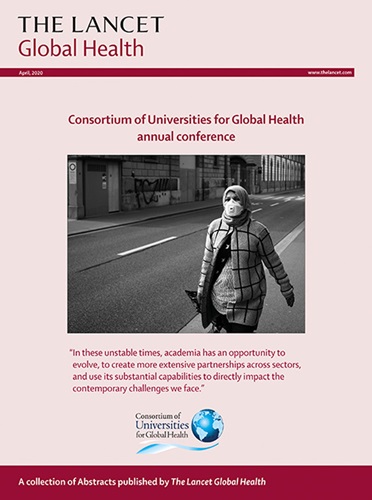极端贫困中老年人非传染性疾病风险因素和慢性病的流行:在印度进行的一项具有全国代表性的横断面研究。
IF 19.9
1区 医学
Q1 PUBLIC, ENVIRONMENTAL & OCCUPATIONAL HEALTH
引用次数: 0
摘要
背景:关于非传染性疾病(NCD)在极度贫困的成年人中流行的证据很少。我们的目的是确定印度极端贫困的中老年人中非传染性疾病风险因素和慢性疾病的国家和次国家流行率,全球这一年龄组的极端贫困人口中有很大一部分生活在印度。在这项横断面研究中,我们分析了印度纵向老龄化研究的基线数据(2017- 2019年),使用世界银行设定的国际贫困线(按2011年购买力平价美元计算)为1.9美元来定义极端贫困。结果包括代谢(如高血压)和行为(如吸烟)风险因素以及慢性疾病(如抑郁症)。我们进行了加权描述性分析,以获得患病率估计值和多变量泊松回归,以估计极端贫困参与者中按性别和居住地划分的所有结果的相对风险差异(n=11 243)。我们还根据世界银行的三个贫困线(≤1.90美元、1.91 - 1.20美元和3.21 - 5.50美元对5.50美元),将所有参与者(n=66 617)划分为相互排斥的组,根据贫困水平估计了所有结果的相对风险。在这个具有全国代表性的样本中,年龄在45岁及以上的66617名成年人中,男性占53.4%,女性占46.6%,年龄在45-54岁之间的占39.2%。在极度贫困的参与者中(11 243人[18.1%]),最普遍的危险因素和慢性疾病是烟草使用(40.3% [95% CI 39.2 - 41.5])、虚弱(39.0%[37.9 - 40.2])和高血压(28.7%[27.7 - 29.8])。具体结果的流行率因州和地区而异,相对风险因居住地、性别和贫困水平而异。解释:在印度,极端贫困的中老年人与非极端贫困人群相比,某些非传染性疾病风险因素和慢性病的患病率较高,但各州、地区和亚群体的患病率差异很大,因此需要针对特定地理区域和亚群体制定更有针对性的公共卫生政策。美国国家老龄研究所,美国国立卫生研究院。本文章由计算机程序翻译,如有差异,请以英文原文为准。
Prevalence of non-communicable disease risk factors and chronic conditions among middle-aged and older adults in extreme poverty: a nationally representative cross-sectional study in India.
BACKGROUND
Evidence on non-communicable disease (NCD) prevalence among adults in extreme poverty is sparse. We aimed to determine the national and subnational prevalence of NCD risk factors and chronic conditions among middle-aged and older adults in extreme poverty in India, where a large share of the global population in extreme poverty in this age group lives.
METHODS
In this cross-sectional study, we analysed baseline data (2017-19) from the Longitudinal Ageing Study in India using the World Bank's international poverty line set at $1·90 in 2011 purchasing power parity dollars to define extreme poverty. Outcomes included metabolic (eg, hypertension) and behavioural (eg, tobacco use) risk factors, and chronic conditions (eg, depression). We conducted weighted descriptive analyses to obtain prevalence estimates and multivariable Poisson regression to estimate differences in the relative risk of all outcomes by sex and residence among participants in extreme poverty (n=11 243). We also estimated the relative risk of all outcomes by poverty levels by categorising all participants (n=66 617) into mutually exclusive groups based on the three World Bank poverty line cutoffs (≤$1·90, $1·91-3·20, and $3·21-5·50 versus >$5·50).
FINDINGS
In this nationally representative sample of 66 617 adults aged 45 years and older, 53·4% were male, 46·6% were female, and 39·2% were aged 45-54 years. Among participants in extreme poverty (11 243 [18·1%]), the most prevalent risk factors and chronic conditions were tobacco use (40·3% [95% CI 39·2-41·5]), frailty (39·0% [37·9-40·2]), and hypertension (28·7% [27·7-29·8]). The prevalence of specific outcomes varied across states and territories, and the relative risk differed by residence, sex, and poverty levels.
INTERPRETATION
Middle-aged and older adults in extreme poverty in India have a high prevalence of some NCD risk factors and chronic conditions than those not in extreme poverty, but prevalence varies substantially across states and territories and subgroups, calling for more targeted public health policies for specific geographical areas and subgroups.
FUNDING
US National Institute on Aging, National Institutes of Health.
求助全文
通过发布文献求助,成功后即可免费获取论文全文。
去求助
来源期刊

Lancet Global Health
PUBLIC, ENVIRONMENTAL & OCCUPATIONAL HEALTH-
CiteScore
44.10
自引率
1.20%
发文量
763
审稿时长
10 weeks
期刊介绍:
The Lancet Global Health is an online publication that releases monthly open access (subscription-free) issues.Each issue includes original research, commentary, and correspondence.In addition to this, the publication also provides regular blog posts.
The main focus of The Lancet Global Health is on disadvantaged populations, which can include both entire economic regions and marginalized groups within prosperous nations.The publication prefers to cover topics related to reproductive, maternal, neonatal, child, and adolescent health; infectious diseases (including neglected tropical diseases); non-communicable diseases; mental health; the global health workforce; health systems; surgery; and health policy.
 求助内容:
求助内容: 应助结果提醒方式:
应助结果提醒方式:


